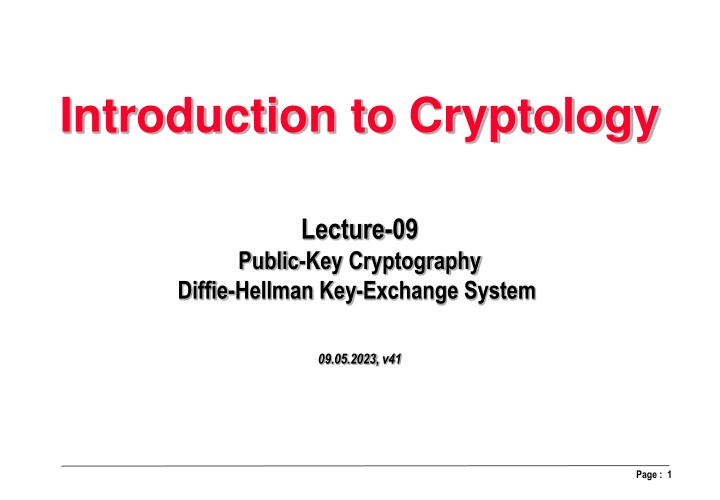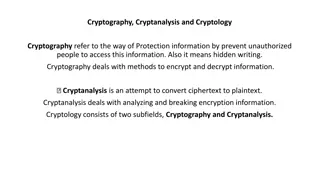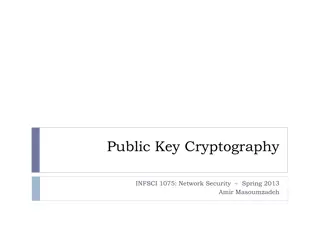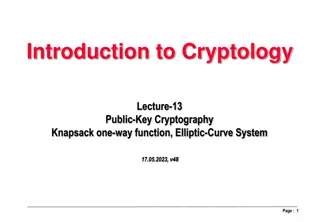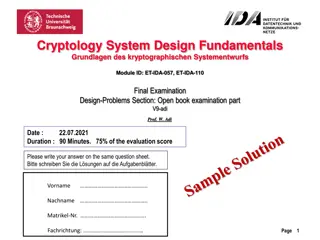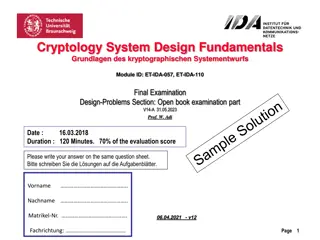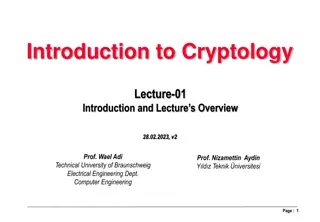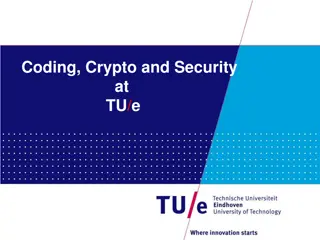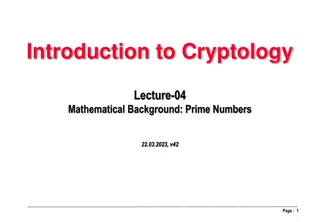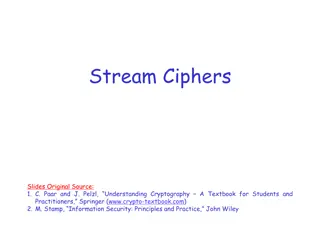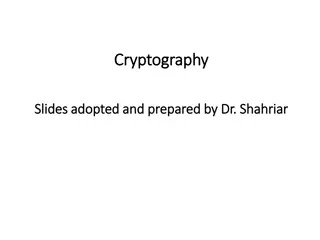Introduction to Cryptology
Public-key cryptography revolutionized secure communication by eliminating the need for exchanging secret keys, as seen through the breakthroughs of Shannon and Diffie-Hellman. This lecture outlines the significance, principles, and challenges within this cryptographic system, paving the way for modern cryptology.
Download Presentation

Please find below an Image/Link to download the presentation.
The content on the website is provided AS IS for your information and personal use only. It may not be sold, licensed, or shared on other websites without obtaining consent from the author.If you encounter any issues during the download, it is possible that the publisher has removed the file from their server.
You are allowed to download the files provided on this website for personal or commercial use, subject to the condition that they are used lawfully. All files are the property of their respective owners.
The content on the website is provided AS IS for your information and personal use only. It may not be sold, licensed, or shared on other websites without obtaining consent from the author.
E N D
Presentation Transcript
Introduction to Cryptology Lecture-09 Public-Key Cryptography Diffie-Hellman Key-Exchange System 09.05.2023, v41 Page : 1
Lecture Outlines Historical Overview Public Key Principles and its Breakthrough Diffie Hellman Public Key Exchange System Page : 2
Historical Public-Key Breakthrough in Cryptography Shannon s Breakthrouh in Communication Technology in 1948 1- Shannon (AT&T) 1948 'A Mathematical Theory of Communication Shannon s Breakthrough in Communication: Error-free transmission is possible on noisy channels! C= B log2(1 + S/N) His second publication on secrecy systems one year later: 2- Shannon (AT&T) 1949 'Communication Theory of Secrecy Systems However, Shannon introduced no breakthrough in cryptography but he introduced mathematical mean to deal with security systems and proved that: Vernam Cipher is perfect and is unbreakable The Breakthrough to the Modern Cryptology came in 1976 Diffie and Hellman (Stanford University) introduced the Concept of the Public key Cryptography in 1976 Diffie Hellman s Breakthrough in Cryptography: Secured transmission is possible on unsecured channels without any secret agreement! Unfortunately: No unbreakable (perfect) public-key system is so far known !!!! A possible future breakthrough is to find a non-breakable public-key system? Page : 3
Why Public-Key Cryptography ? Question: How many secret-keys needed to be exchanged in order to set up a system of n-users? 1 1 n 4 .. . 2 5 2 3 3 n (n-1) keys for n users 2 10 key-exchanges for 5 users For 10 000 users, we need 50 million key- exchanges. This is very hard ! Public-key systems makes this exchange unnecessary Page : 4
The Target of Public Key Cryptography is to communicate securely without prior secret key exchange Ciphering Receiver De-Ciphering Sender Y = E (Z,X) E ( Z,X ) X X D ( Z,Y ) Message Message Channel Z Z Public-Key system drops out that secret-key- Channel/agreement completely Secret Key Channel Secret Key = Z Secret key exchange is very hard and non-practical!: Page : 5
The Solution was The breakthrough discovery of Public-Key Cryptography by Diffie and Hellman in 1976 Ciphering Receiver De-Ciphering Sender Cryptogram = Y MessageX E( Ze, X ) D( Zd, Y ) X Message Replace secret-key channel by a public register Open negotiation Public Directory to replace the secret keys channel Public Open Agreement No Prior Secret Communication ! Page : 6
Basic Public-Key Changes Concept (Mechanical Model) Key Idea of Public Key Systems: Using two different keys! Conventional Secret Key Systems K-public (for locking) K-secret (for unlocking) K-open K-close (Asymmetric System) K-open = K-close (Symmetric System) - Open and close with different keys!! - No Secret Key Agreement required -Open and close using the same key which need to be agreed on secretly !! First two schemes in Public Key Cryptography: Diffie-Hellman key exchange scheme 1976 RSA public key secrecy system 1978 Page : 7
Public-Key Cryptography First introduced by Diffie and Hellman 1976 (Stanford University) Key Revolutionary Idea for sharing a secret: no need for any prior secret agreement in order to share a common secrets HOW ? K-secret kept secret 1. Every user generates two keys: published K-public 2. Any two users start open negotiations resulting with exclusively shared secret ! Diffie and Hellman showed how could that work securely under some assumptions! Page : 8
Open Key-Agreement Breakthrough 1976 Shared Secret without exchange of secrets Mechanical simulation Diffie-Hellman proposed mechanism Open Register A B K-public-A K-public-B Secret key-B Secret key-A SHIELD (open agreement) ! Same thing ! Shared Secret Page : 9
The key-question in Public-key systems is How to publicly hide (shield) a secret ? Key idea: by using the so called One-way Functions (OWF) Diffie and Hellmann proposed to use a One-Way function: Secret shielded secret 6 9 SHIELD = One Way Function How: 21=2 22=4 23=8 24=5 25=10 26=9 Complexity O( p) Chang algorithm p (1000 bits) Complexity 2500 2 6mod 11 = 9 To reveal the secret 6: Compute log29 (mod 11) = 6 This Discrete Logarithm computation is still one unsolved problem! (claim: no proof!) : No efficient published algorithm is known to compute the secret 6 as log29 modulo 11 ! Page : 10
Example for Diffie-Hellman key exchange scheme 1976 Widely use in internet and banking ... Open Agreement and Register Shielding function is: y = (2x) mod 11 A B 29= 6 25= 10 K-open-B= 6 K-open-A= 10 Secret key-B= 9 Secret key-A= 5 25 29 10 6 5 ( ) ( ) 9 29 25 Shield ! same thing ! Z = 245= 10 mod 11 2 9.5 2 5.9 Page : 11
Conventional Diffie-Hellman Public Key Distribution System Open Directory User B xb= secret key of B User A xa= secret key of A primitive element in GF(p) ya= Xapublic key of A yb= Xbpublic key of B ya A, yb B, xb xa [yb] [ya] mod (p-1) In the exponent ! xaxb xaxb in Zp ZAB= ZAB= in Zp Shared Secret: ZAB= xaxb Page : 12
Example: A public key exchange system is setup according to Diffie-Hellman key exchange scheme with y = 7Xmod 23 1. 2. Compute the public keys YA, YBof users A and B if their secret keys are XA=5 and XB=4 respectively. Compute the common shared secret ZABbetween users A and B according to Diffie-Hellman key exchange scheme Solution two-way exchange : Secret Key XA= 5 Secret Key XB= 4 Public key for user B is : YB= 74 mod 23 = 9 Public key for user A is : YA= 75mod 23 = 17 ZAB= 17 4mod 23 = 8 ZAB= 9 5mod 23 = 8 Common Secret is = 8 Page : 13
Practical Use Cases of Diffie-Hellman-Lock as Public-Key Systems Three selected application scenarios: 1- SEEK: (Secure Electronic Exchange of Keys) 2- Authenticated Public Key Distribution System 3- Two-Way Authenticated Public Key Distribution System - Many other scenarios . Page : 14
SEEK Secure Electronic Exchange of Keys A Public-Key Secrecy System Based on Diffie Hellman Key exchange Scheme [SEEK (Omura) cryptosystem 1985] Step 1: DH-Key agreement Open Directory Arithmetic in GF(q) = primitive element in GF(q) User B User A 1 Ea Ea Ea= secret key Eb= secret key 2 Eb Eb Eb Ea Z=( ) = Z=( ) = Ea Ea Eb Eb Eb Ea shared secret key = Z If gcd(Z, q-1) = 1, then Z is adopted as a suitable shared key. [ the inverse of Z is computed as D = Z-1(mod q -1) ] If gcd(Z, q-1) 1, then repeat step 1 above until Z becomes invertible. Step 2: Data Encryption and Decryption by Exponentiation in GF(q) D ( ) Z Z Z M M = M M Page : 15
Two-Way Authenticated Public Key Distribution System Based on Diffie-Hellman Scheme (Alexandris, Burmester, Chrissikopoulos, Desmedt ,1993) Open Directory User B User A primitive element in GF(p) ya= Xpublic key of A yb= Xbpublic key of B a xa= secret key of A r1= random in Zp-1 xb= secret key of B r2= random in Zp-1 Ea= ( r1- xa) in Zp-1 Eb= (r2- xb) in Zp-1 B, Eb A, Ea r2 Ea ]r1 Eb [ ya. ] [ yb. in Zp in Zp r2 r1 xb xa r2-xb r1- xa r1 r2 r1 r2 [ ] = [ ] = . . r1 r2 Shared Secret: ZAB = Page : 16
Two-Way Authenticated Public Key Distribution System Based on Diffie-Hellman-Hughs Scheme (Shared-key enforced by user A !) Open Directory User B User A : as primitive element in GF(p) r = random in Zp-1 such that: gcd( p-1, r ) = 1 Compute r -1in Zp-1 xa= secret key of A Y1= r Z = Xa Y2 = [Y1]Xa= r. Xa Y2 r-1 r-1 [Y2 ] = [ r. Xa] User A can enforce a certain key value Z ! = Xa= Z Page : 17
Remarks on Diffie-Hellman (DH) Public Key System Security considerations and few known facts: 1. Based on the claim that the discrete logarithm which is claimed to be not efficiently computable Breaking Complexity: A primitive element from GF(p) or GF(2m) is used to make exhaustive search algorithms infeasible. If y = I, only y and are known. To break the system, we need to find i. To find i, the powers tare computed in the given GF until y = t, then i=t. A maximum of p-1 or 2m-1 cycles are required by a primitive search to find the discrete logarithm t (smarter algorithms require less complexity to compute t). The order of as a primitive element is p-1 in GF(p) or 2m-1.in GF(2m). Therefore, p is selected as 1000 to 4000 bit prime or m> 1000 to attain a good security level. Best known cryptanalysis algorithms are proportional to p (Chang). 2. Caution: There is no evidence that no efficient algorithms can be found to break the system . Hint: When designing DH system, (p-1) should have large prime factor to make the discrete logarithm computation infeasible (p is called then a strong prime). 3. Page : 18
Design Summary for Diffie-Hellman (DH) Public Key Exchange System A possible design procedure for DH system over GF(p) is: 1. Select a strong prime number p such that p-1 = 2 q where q is a prime. A possible procedure is to use Pocklington s Theorem to find such a prime: - Select N = 2q + 1 where q is a large prime Check if the resulting N is prime according to Pocklington s theorem - If N is prime, take p=N to define GF(p) Find a primitive element in GF(p) by selecting any non-zero random value and checking if its order is p-1. The order of any element in GF(p) is a divisor of p-1=2q. That is the order can be either 1, 2, q or 2q. If 2 1 and q 1 then the order of is 2q and is a primitive element. Repeat 3 until you get a primitive element. 2. Publish GF(p) and in a public directory. The system is ready for use. 3. NOTICE: the one who generates p should be trustable! (fake prime!) Notice: There are other algebraic groups for creating DH systems other than those in GF(p) or GF(2m). One widely-used system would be shown in a later sections in this lecture. (Additive Groups in Elliptic-Curves) Page : 19
